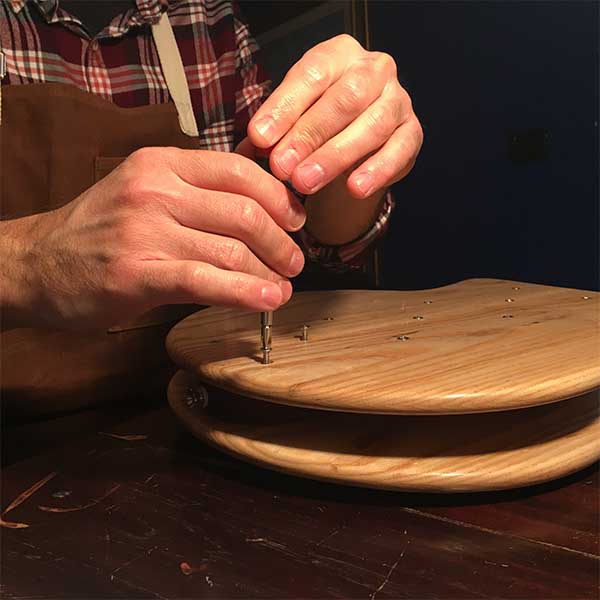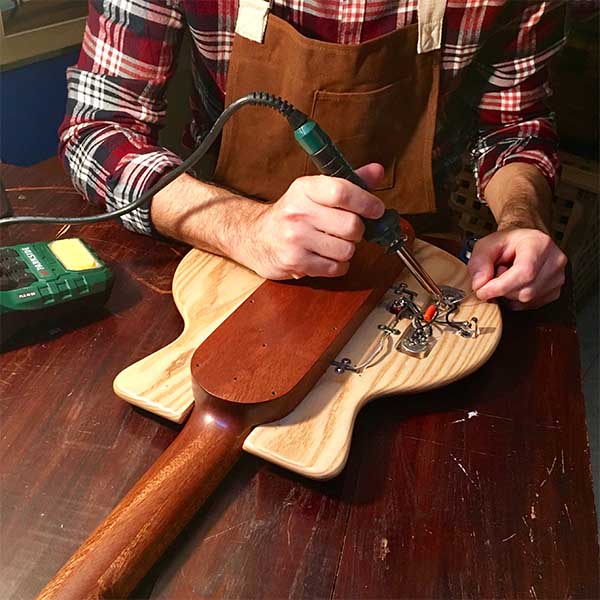What do you think when someone says that a particular electric guitar is handmade? I don’t know about you, but I get the feeling I’m supposed to believe this instrument is a quality item that’s a cut above your average factory-built guitar.
But hold on a minute. Is a handmade guitar really any better than one that’s machine-made? And actually, is there even any such thing as an entirely handmade guitar or an entirely machine-made guitar? Before we throw ourselves headstock-first into the argument, we should define some terms.
What do we mean by handmade? It’s unlikely, if not downright impossible, that you or I or anyone else could make a guitar with their bare hands. "Handmade" can’t mean that someone literally uses their hands only. Presumably, then, the term is used to imply that this handy guitar maker uses hand tools. You know—hammers, files, saws, gougers, markers—that sort of traditional thing, not to mention several drawerfuls of specialist items.
What do we mean by machine-made? There’s what we might call a traditional set of machines used in guitar making: routers, sanders, planers, bandsaws, drills, and so on. More often, though, "machine-made" implies the use of CNCs. These are tools or machines controlled by a computer—the abbreviation stands for computer numerical control. Peavey pioneered their use for guitar-making back in the late ‘70s, and since then CNCs are everywhere you look in guitar-making—from small workshops to big factories.
There’s overlap here. That handy maker with all those tools will almost certainly use some of the traditional machines as well, even if the end result gets called handmade or something similar. And machine-made? I’ve turned to John Suhr for some advice on our subject.
John has run Suhr Guitars in California since 1997, and before that he worked at the Fender Custom Shop, while some of his earliest creations came with the Pensa-Suhr brand in New York City in the ‘80s. These days he reckons that, as far as the numbers go, Suhr is at the high end of boutique building. "Bigger than someone like Tom Anderson," he says, "smaller than someone like Ernie Ball/Music Man, and nowhere close to PRS or anyone like that."

In other words, he must have tried every which way of solidbody guitar-building in his long career. So how does he feel about machine-made guitars? "There is no such thing as a completely machine-made guitar," he replies. How do you mean? "All of us CNC guys joke about how, oh yeah, we just pour sawdust in one end and the guitar comes out the other." So that’s not how it works? "No," he says with a chuckle. "To me, the guitar is everything that happens after the wood is cut. For a body, say, you can cut the wood with a pin-router or a CNC, but whichever method you use, you’re still just creating a raw body."
After that raw body is cut, he says, it still needs to be sanded by skilled people, because a poor worker can quickly ruin things by sanding the wood badly. "To me, that’s where the soul of the instrument starts to come together," he says. "Every maker has a different view on how a fret end should look, say, or how the neck pocket should look. So a guitar manufacturer has to train their employees to do it with their vision. And none of that really has to do with machines."
The choice John talks about where a maker can cut a guitar body with a pin-router or a CNC is mostly to do with scale and cost—and also with attitude. "Do you put your car up on a proper lift and elevate it six feet over your head, or are you going to crawl under it and just put the wheels up on some jacks? You can get the job done either way, but one way sure is a lot nicer than the other," he says.
Going the handmade route at this stage, with a template and a pin-router, will work for a small shop making a handful of guitars. A pin-router? It’s a machine with a table and a large "pin" that rides against a template, cutting the raw piece of wood on top of the template as the operator guides it around, thereby matching the shape of the template. "That’s the way the old Fender bodies were made," John explains. "Then there are shaper tables, which Fender used to cut necks, very large cutters, maybe three or four inches in diameter, which would cut the back shape of the neck against a template."

CNC machines are relatively expensive compared to the few thousand dollars you might need for a typical pin-router. "In reality, making a handmade guitar is far easier than it is to make a CNC guitar. It requires a lot less money. The cost of admission for CNC will be maybe ten times greater than going out and buying a pin-router," John estimates. "A good CNC can be a hundred grand, and a maker would need to spend at least 30 grand for a decent, small CNC operation. I’d recommend using CAD [computer-aided design], so you’re going to have to learn how to draw. And after you learn to draw, you have to learn how to program the machine, or you need to get someone who can do that for you. All things considered, it’s a lot more difficult and a lot more expensive to cut guitars on a CNC. But, of course, the benefit is accuracy and repeatability."
Ah, repeatability. That’s the essence of medium to large-scale modern guitar-making. And the small shop with a pin-router and some other machines and tools may not be too interested in that concept. This is the environment where the handmade guitar comes to life, and the whole point is that this or that guitar is different from the next one and different from the one that came before it.
Some jobs benefit from the accuracy of a CNC in a way that cannot be achieved with by-hand methods, such as creating the truss-rod channel or cutting the fret slots. "I don’t think I’d want to cut slots any other way," John says. "I want each fret slot to be cut by one saw, individually, with the accuracy of a fine-tuned engine. To me, those fret slots need to be put exactly where you think they’re going to be, whether or not you’re using compensations. Otherwise there’s no ground zero. CNC is no different than having an accurate chisel in your toolbox, or a great set of calipers. Even if I was doing guitars on a pin-router, I would find a CNC guy to cut the slots on my fingerboards."
It’s doubtful if you could tell if the parts of your guitar were cut on a pin-router or on a CNC. "It has nothing to do with the cut parts," John insists. "When I started out, I was a kit builder. I would buy necks and bodies from Schecter or Tom Anderson or Warmoth, but in my opinion the talent came with being able to take those parts, put them together, and make it not feel like a Partscaster. It needs to feel like a completed instrument instead of a bunch of bolted-on parts. The people who say you can just go buy a neck, buy a body, bolt them together, and you’ve got a cheap Strat—it’s hit and miss. There’s no guarantee."
He tells a story about Marshall Crenshaw, who would bring him the old Hagstroms and Voxes he loved, largely unplayable, and John would get to work replacing the frets, truing the fingerboards, putting in better electronics, setting them up. "In the end, he had something that was really funky but was now a great player. And that shows to me that most things can be corrected, with great fretwork, great setups, great electronics, if the general dimensions are there."
Guitar builders big and small continue to get their hands on the tools and machines that help them make the guitars they want to make. Those tools and machines might be from a long line of traditional items that have proved over decades how right and suitable they are for the job in hand. Others draw on the latest changes in technology to adapt, improve, and even change working methods and systems.
And, of course, there are concerns beyond such considerations as handmade or machine-made or such questions as to CNC or not to CNC. "It doesn’t matter what machines you’re using," John Suhr concludes. "If you can’t cook, or you’re a bad doctor, or you’re a bad guitar builder, I don’t care what machine I give you. It’s not going to make it any better."
About the author: Tony Bacon writes about musical instruments, musicians, and music. He is a co-founder of Backbeat UK and Jawbone Press. His books include The Stratocaster Guitar Book, Fuzz & Feedback, and Electric Guitars: Design & Invention. Tony lives in Bristol, England. More info at tonybacon.co.uk.




